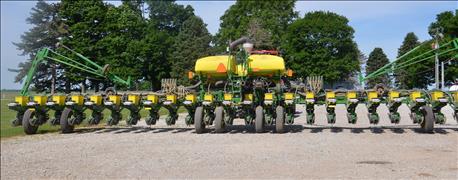
You are tired of weather delays pushing planting dates back. Your goal is to somehow increase planting capacity so that when soil conditions are right, you can cover more acres per day.
The Profit Planners panel suggests options for reaching this goal. Panel members include David Erickson, farmer, Altona, Ill.; Mark Evans, Putnam County Extension, Greencastle, Ind.; Steve Myers, farm manager with Busey Ag Resources, Leroy, Ill.; and Chris Parker, farm management specialist, Morgantown, Ind.

CONSIDER ALL ANGLES: There are trade-offs to however you go about increasing planter capacity, experts say. Give it thought before making a decision.
Question: We were short on planter capacity last spring due to weather delays. My partner wants to either buy a second planter or trade for a bigger planter. I would rather invest in GPS equipment so we could run all night with the planter we have. We have a yield monitor, but haven’t moved into autosteering and GPS control yet. Which option makes the most economic sense?
Erickson: Running all night, especially for planting, may not be the best choice, or even a possible choice. Weather and soil conditions could play an important role in determining if this is wise to consider. It appears you and your partner have very different approaches. Get some estimates for what it would take for each option that you are contemplating. This should help lead you to the economics of the decision, but again, don’t forget the impact weather can have on even your best-made plans.
Evans: Manpower and the spread of the farm operation are key factors to consider. If there are enough bodies to run two planters and spread out over a larger area, that makes sense. It also spreads out the risk of a breakdown, even though there would be additional costs for tractors and keeping planters full. If you will also use the GPS to conduct decision-making to improve profitability, and your manpower is set up to have one machine run day and night, then that would be a better position for the operation.
Myers: Each option has its own merit, but consider the faults. A second planter requires additional capital, another power unit and labor. The bigger planter requires capital and probably a bigger power unit. The GPS requires big hours, but could possibly be useful for work other than planting. Ask how fully you are using your existing system, and calculate field efficiency for each possibility. Also consider the "downtime" activities like loading or traveling from field to field to possibly squeeze extra acres into a day.
Parker: Do you have the manpower to actually plant all night? Even with autosteer, you still need a driver and accompanying support staff. My concern is safety issues with working so many hours. I vote for a bigger planter that can do 30-inch corn and 15-inch soybean rows as opposed to maintaining two planters.
Summing up: All three options share pluses and minuses. Work the numbers for each one. However, you also need to account for the intangibles, like continuing to work while everyone is tired if you run 24/7.
About the Author(s)
You May Also Like




